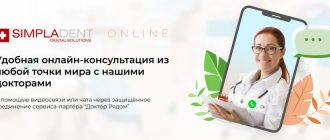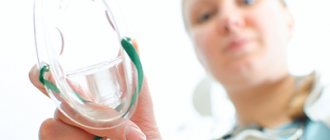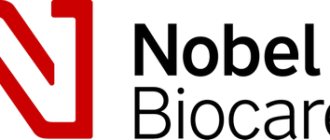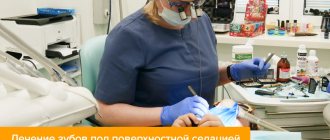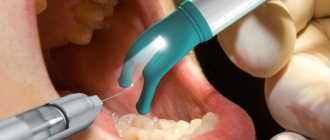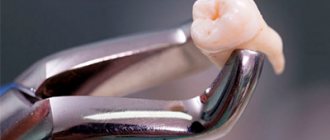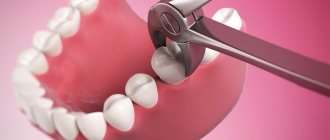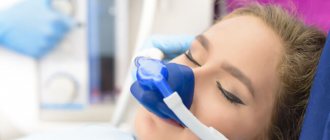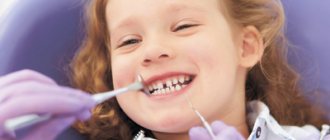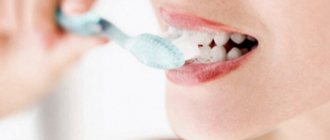STORIES
Content
In modern dentistry, anti-stress treatment methods have been successfully used for a long time, which is especially important for children. In particular, Sevoran anesthesia allows children to avoid anxiety and pain and treat their teeth with comfort. After waking up, the child will not experience unpleasant sensations, he will not be disturbed by unpleasant memories. The absence of psychological trauma will save the child from dental phobia and will lead to the fact that in the future he will consult a doctor as soon as he feels some kind of problem with his teeth, and will not wait until the last minute, when the tooth most likely cannot be saved.
Advantages of the method
Reviews of the treatment of children under Sevoran are in most cases positive. Advantages of Sevoran:
- Painless. Sevoran is given through a mask and not intravenously.
- Speed of impact. The child falls asleep instantly.
- Controllability. The doctor can easily monitor the depth of anesthesia.
- No consequences. After recovery from anesthesia, discomfort is minimal.
- Safety. There is no negative effect on the children's body.
Sevoran anesthesia for children in dentistry
When treating children's teeth, Sevoran anesthesia has actually become the standard. Its use provides invaluable benefits.
Complete security. Sevoran is approved for use in children over one year of age. This drug has been well tested, tested, and has been used for quite some time. It does not cause severe side effects, does not place a large burden on the body, and no toxic metabolites are formed when administered. It only works as long as it is supplied through a special mask; as soon as the doctor turns off the supply, the effect stops, and after a few minutes the patient wakes up, except in those cases when the medicated sleep turns into normal and the child no longer sleeps under the influence of the drug, but on its own.
Perfect efficiency. Under the influence of the drug, the child does not experience any discomfort, pain, anxiety - he sleeps soundly, and the doctor carries out treatment at this time. Sevoran has not only a sedative and hypnotic effect, but also an analgesic effect, so it is used even in cases where local anesthesia cannot be used (for example, due to allergies) or may be insufficient (for extensive dental procedures).
Ease of administration. Sevoran is an inhalation drug that is administered through a breathing mask. In this case, no injections or intravenous injections are necessary.
Hypoallergenic. There is no allergy to this drug. It is also used in cases where the patient has allergic reactions to other anesthetics.
The Dental Master clinic has the necessary licenses for anesthesiology and resuscitation, allowing you to perform treatment under anesthesia. We also have all the necessary modern equipment and highly qualified doctors. During treatment, the child is under constant supervision of an anesthesiologist, who, using special equipment, monitors the baby’s condition and will take appropriate measures if any changes occur.
What are the indications for use of the drug Sevoran?
The main indication for dental intervention in children and adolescents is the need to preserve temporary and permanent unformed teeth. Early removal of primary teeth leads, first of all, to disruption of bite formation. Carious teeth are a source of infection not only for the permanent tooth buds located underneath them, but also for the entire organism as a whole. Chronic diseases develop and immunity decreases.
There are situations when dental treatment must be performed under general anesthesia. Here are some of them:
- Young children (1 - 4 years old) cannot yet interact with a dentist.
- Previous negative (negative) treatment experience (dental phobia syndrome).
It is precisely attempts at treatment at such a tender age (1 - 4 years), especially if treatment was carried out while holding the child, that lead to the formation of a fear of dental interventions for the rest of his life.
In addition, with retention treatment, the quality of dental treatment decreases, dental problems become even worse, and treatment becomes even more complex and lengthy. But the most difficult thing is not to cure the baby’s teeth, but to restore his trust in the doctor.
Main indications:
- Children and adolescents with organic lesions of the central and peripheral nervous systems (cerebral palsy (CP), autism, mental retardation, encephalopathy), as well as genetic diseases, such as Down's disease.
- Parents' desire to have all their teeth treated in one visit.
- Intolerance to drugs for local anesthesia (severe allergic history).
In what cases is mask anesthesia with Sevoran used in children?
There are specific indications for the use of Sevoran for children in dentistry:
- age 1-3 years – at this time it is difficult for a child to sit still in the dentist’s chair, which makes treatment difficult, and in some cases makes it impossible,
- panic fear of the dentist, which cannot be eliminated in other ways,
- allergy to local anesthetics, which will not allow for quality treatment,
- various diseases, as well as developmental features that do not allow the doctor to establish contact with the child,
- a large amount of dental intervention requiring prolonged treatment or serious impact (for example, tooth extraction).
In each specific case, the pediatric dentist of our clinic discusses in detail the prospects for treating the child under anesthesia with the parents, talks about all the nuances, explains the advantages and features of the technique, and invites an anesthesiologist for consultation.
How do you prepare for sleep treatment?
Stage 1. Consultation with a dentist.
During the consultation, the attending dentist conducts an examination of the oral cavity and x-rays if necessary, draws up and agrees with the parents on a plan for the upcoming treatment, and sets a date.
The dentist will give you a referral note on how to prepare for treatment under anesthesia, which contains the following information:
- rules for preparing for anesthesia (about fasting and dry pauses and the importance of observing them)
- referral for tests and examinations (usually an ECG, general blood test and hemosyndrome test)
- recommendations for preparation for analysis
We strongly recommend that you undergo these examinations with us, as we trust our specialists and laboratory. We offer discounts on pre-treatment examinations: 10% on tests and 50% on ECG.
Stage 2. Exploratory survey.
The next day, you and your child come to the clinic, take tests, do an ECG and fill out a detailed questionnaire about the child’s health, where you must indicate all the features of the child’s development, information about past and chronic diseases.
We understand that treatment under general anesthesia for parents is an unfamiliar procedure that causes anxiety, so do not be shy - ask anything that interests you! The nurse anesthetist will answer all your questions about the procedure for preparing and conducting treatment under general anesthesia.
All examination results are transmitted to the anesthesiologist. After reviewing them, the doctor, if necessary, contacts the parents by phone, asks clarifying questions, and refers them for consultation to specialized specialists. If necessary, schedules an additional meeting with the patient.
Stage 3. Consultation with an anesthesiologist-resuscitator.
On the day of anesthesia, before the start of treatment, the anesthesiologist examines the child and once again asks the parents in detail about compliance with the rules of preparation for anesthesia. If all the requirements are met and the examinations are in order, there are no contraindications, we begin treatment.
Treatment of baby teeth with sevoran
Parents often ask themselves the question: is it worth treating a child’s baby teeth if they are already falling out? There is some reason for this - indeed, to waste energy, force the child to undergo not very pleasant treatment procedures only so that the cured tooth falls out after a short time and a permanent one grows in its place. But the thing is that replacing baby teeth with permanent ones is a long process. On average it lasts approximately 10 years. But it is not at all uncommon for individual baby teeth to survive until the age of 20 or even 30 years. Imagine that this particular baby tooth will fall out in a child only after 10 years. Will he suffer all these years? And then, even if the baby tooth does not hurt much, but simply collapses, what will the child chew on until his permanent tooth erupts?
Simply put, it makes no sense to treat only those baby teeth that are already loose and close to falling out. But those that are still holding up well can and should be treated.
Treatment of baby teeth with Sevoran will be completely painless and comfortable. The method is no different from the treatment of permanent teeth.
Dental treatment in children with nitrous oxide: how does it work?
As already mentioned, the use of nitrous oxide occurs almost everywhere. Although the procedure is relatively simple, it should only be performed by a licensed anesthesiologist. In addition, if the clinic offers sedation services, there should also be a resuscitator on duty who can provide first aid if the need arises. The procedure begins with preparation. 10 hours before sedation you need to stop eating and come to the clinic on an empty stomach. If the child is small, then preparation for sedation is done in a playful way so as not to frighten or embarrass him. The process of sedation with nitrous oxide begins by first delivering 100% oxygen at a certain rate. Then nitrous oxide is added: its concentration ranges from 30 to 50%. Then the doctor administers local anesthesia, since the ZAX is designed to calm the child and remove stress, and pain relief is carried out separately. During the treatment process, the doctor communicates with the child, monitors his condition and, if necessary, asks him to take certain actions. After the manipulations are completed, the supply of nitrous oxide stops, and after 10–15 minutes the gas completely leaves the body.
Method of dental treatment under anesthesia Sevoran for children
Sevoran is administered in two stages - the initial administration through an oral-nasal mask, and then, when the child has fallen asleep (literally after 2-3 breaths), a laryngeal mask is placed, through which the patient breathes during treatment. Local anesthesia can only be used in cases where it is necessary to extend the analgesic effect for a period after treatment and after the end of anesthesia (for example, when several teeth are removed). Inhalation anesthesia with Sevoran is effective only during its introduction into the body. Once the feed stops, most babies are usually awake within 20 minutes.
Children cope with recovery from anesthesia differently, because they themselves are all different, with their own characteristics of the body. Sometimes there may be a short-term lack of coordination of movements, in some cases - a state of excitement. Some people experience dizziness and nausea. Some children may be fussy after waking up - this may be caused by unusual sensations.
Our clinic has a separate room where the child can wake up on his own, naturally in the presence of his parents. Oxygen was supplied to this room to speed up the removal of the remnants of anesthesia from the child’s body, and an anesthesiologist monitored the awakening of the little patient.
PART I
Answered by Konstantin Vladimirovich Artamonov, leading anesthesiologist-resuscitator at the children's dental clinic "Malysh and Carlson."
Tell me, at what age can general anesthesia be used for dental treatment in children?
There are no age restrictions for treatment under general anesthesia. For example, under general anesthesia, reconstructive operations are performed for congenital anomalies of the structure of the maxillofacial region, for example, cleft palate in children in the first months of life.
In our clinic, we treat dental diseases for children aged one and a half years and older under general anesthesia. We recently treated decayed upper front teeth of a nine-month-old baby. The parents brought the child from abroad, since such treatment is not provided there.
On the websites of leading children's dental clinics they literally praise sevoran anesthesia, but not a word is written about its shortcomings. Tell me, does the drug Sevoran really have any disadvantages?
It would be incorrect to say that Sevoran (sevoflurane) is an ideal drug in anesthesiology. There is simply no ideal drug. However, Sevoran anesthesia (ABBOT Laboratories USA) really has virtually no side effects. Due to the low solubility of the drug in the blood, administration and removal from anesthesia occur quite quickly, which reduces the metabolism of the drug in the body to a minimum. And in the process of metabolism, non-toxic products are formed (unlike other inhalational anesthetics).
Side effects of Sevoran include dizziness upon awakening, which persists for about 30 minutes, as well as rapid restoration of pain sensitivity after recovery from anesthesia (therefore, local anesthesia is required for traumatic procedures), nausea and vomiting may occur.
In genetically predisposed patients, skeletal muscle hypermetabolism syndrome (malignant hyperthermia syndrome) may occur, the incidence rate is 1:50,000 - 1:100,000 (according to statistical data from various Russian and foreign sources).
Please help me figure out which anesthesia is safer for a child: inhalation or intravenous.
The choice of anesthesia is determined by a combination of factors, primarily the general somatic status of the patient and the scope of the upcoming treatment. Dental treatment in children on an outpatient basis is possible both using inhalation anesthesia with Sevoran (general anesthesia) and intravenous anesthesia with propofol (superficial and deep sedation) with the same degree of safety. Patient safety in our clinic is ensured by the use of modern anesthesia and respiratory equipment and hemodynamic monitoring. The anesthesiologist selects an individual dose of the drug for each child, which means that the little patient receives exactly the amount of anesthetic that he needs.
How does a child fall asleep?
The use of inhalational anesthetics during general anesthesia is all the more preferable for children because to induce anesthesia you just need to breathe through a mask, and in the case of intravenous anesthesia, you must have an intravenous catheter. Therefore, in our clinic, if there are no contraindications, inhalation anesthesia with sevoflurane is used, and an intravenous catheter is installed during sleep (for transfusion of the necessary drugs).
During anesthesia, the child does not feel pain during treatment and tooth extraction, but what sensations will he have after waking up?
Sevoran has a sufficient analgesic effect for dental treatment. Indeed, pain sensitivity is restored quickly after waking up - this is one of the few disadvantages when performing inhalation anesthesia with Sevoran. Therefore, when removing teeth under anesthesia, our pediatric dentists additionally perform local anesthesia, trying to carry out traumatic manipulations at the beginning of treatment in order to reduce the baby’s discomfort after waking up. In addition, preemptive analgesia is administered intraoperatively before treatment. In the postoperative period, non-steroidal painkillers (nurofen or paracetamol) are prescribed in age-specific dosages.
How will the child feel and behave after recovery from anesthesia? On the websites of clinics offering dental treatment under anesthesia, they mostly write that after 20 minutes the child is running and playing. Is it so?
The child’s well-being and behavior after general anesthesia depends on several components.
Firstly, the initial psycho-emotional status of the child.
Including previously acquired negative experience of dental treatment “with retention”. Often parents decide to undergo dental treatment under anesthesia when the situation in the child’s mouth is simply catastrophic. There are many inflamed and damaged teeth in the oral cavity. Naturally, when a baby does not sleep for several nights, suffering from toothache, he practically does not eat, and he feels unwell.
Secondly, the volume of dental treatment performed and the duration of anesthesia treatment.
Naturally, when several pulpitis are treated (nerves are removed and canals are filled) and severely damaged tooth crowns are restored, and in some cases tooth extraction cannot be avoided, the child will experience discomfort when waking up. Often, after a long treatment (more than three hours), babies cry because they want to eat.
Sometimes after anesthesia, children experience agitation (excitement). This is due to the fact that when a child wakes up in a half-asleep state, coordination of movements has not been fully restored. Since the child is encountering this condition for the first time, it may bother him.
These are the main factors that determine the child’s condition after general anesthesia. I would like to note that the parents’ mood, their anxiety and vigilance, as well as questions like “Do your teeth hurt, are you in pain?” also worsen the child’s mood after waking up. On the contrary, a calm attitude and the ability to distract a child lead to a quick, positive result: the child is calm, drinks water, watches cartoons.
What is preferable for administering anesthesia to a small child: an endotracheal tube or a laryngeal mask?
In the children's dental clinic "Malysh and Carlson" laryngeal masks from LMA are used to ensure airway patency during general anesthesia. The laryngeal mask is made of thin, soft latex. This is what she looks like. Masks of different sizes are selected depending on the patient’s weight.
Its fundamental difference from an endotracheal tube is that it is located only in the oropharynx and does not penetrate the larynx, which prevents irritation of the respiratory tract and trauma to the vocal cords that occur when using an endotracheal tube. That is why general anesthesia using a laryngeal mask is tolerated by small patients much more comfortably than general anesthesia using an endotracheal tube. But in some cases, tracheal intubation cannot be avoided. In such cases, of course, intubation is used (we have everything necessary for this).
Contraindications to the procedure
In order for dental treatment under Sevoran to be completely safe, it is important to take into account the patient’s health characteristics and not use this type of anesthesia if there are contraindications, which include:
- individual intolerance to this drug (very rare, but does occur),
- hypertension and increased intracranial pressure,
- malignant hyperthermia.
In addition to absolute contraindications to Sevoran anesthesia for children, there are factors in the presence of which this drug should be prescribed with caution, taking measures to relieve possible complications. These factors include:
- cardiovascular diseases (CHD, etc.),
- chronic liver and kidney diseases,
- neuromuscular disorders,
- tendency to seizures,
- simultaneous use of calcium channel blockers (nifedipine, cordipine, verapamil), alpha and beta sympathomimetics (isoprenaline, epinephrine, norepinephrine).
Safety standards of the Doctor Levin center
The center is licensed to use drugs for medicinal sleep, and has the necessary equipment to support patients during treatment and in case of emergency situations.
License
Dental treatment in a state of medicinal sleep can only be carried out by clinics licensed to use drugs. However, licensing the work of an anesthesiology department is a complex and financially expensive task. Rospotrebnadzor places very serious demands on the spatial organization and technical equipment of operating units. It is impossible to re-equip an already operating clinic to meet these requirements. It is quite difficult to comply with all the conditions when opening a new one. Therefore, most clinics either abandon the idea of opening an anesthesiology department or begin to provide the service without a license in violation of the law. The risks of such treatment are not even worth talking about. The price of the issue is human life.
We value both our patients and our reputation. When opening the Center, ensuring the operation of the Anesthesiology and Resuscitation Department in accordance with the requirements of Rospotrebnadzor and the Ministry of Health was one of the initial tasks. we voluntarily undergo inspections by regulatory authorities and confirm the right to provide medical care in the field of anesthesiology and resuscitation.
Equipment
When carrying out therapeutic measures using sedatives, patient safety in our Center is ensured with the help of modern anesthesia-respiratory equipment and hemodynamic monitoring . While the patient is sleeping, an experienced anesthesiologist uses monitors to monitor heart function, levels of oxygen and carbon dioxide during inhalation/exhalation, breathing dynamics, pulse, and blood pressure.
We use only original certified medicines and emergency medicines. In case of emergency, the Center has highly qualified doctors and the necessary equipment for resuscitation measures (defibrillators, ventilators).
Specialists
A staff of experienced anesthesiologists and highly specialized nurses is the main condition for providing high-quality and safe anesthesia. They must be in the department every day full-time, and not come as needed, as is common in most ordinary clinics in Moscow. When the “visiting” doctor is not responsible for anything and does not guarantee anything, the patient cannot feel safe. The lack of full-time anesthesiologists in dentistry is the main obstacle to the widespread dissemination in Russia of the “gold standard” technology - dental treatment during sleep.
In our Center, the safety of patients during dental treatment under sedation is ensured by a full-time highly qualified anesthesiologist-resuscitator Zinoviev Sergey Alekseevich with a total work experience of more than 25 years. Since 2003, he has been the head of the anesthesiology department of the Center. During 18 years of treatment under his supervision, there was not a single complication.
Are there any consequences after using Sevoran in children during dental treatment?
If safety rules are followed, the effects of Sevoran in children are almost always mild (when compared with other types of anesthesia) and short-lived. Mainly:
- dizziness, drowsiness, lethargy - goes away within half an hour,
- nausea and vomiting (in 2-3 patients out of 100),
- increased excitability, moodiness (in about 15 small patients out of 100), mostly due to long abstinence from food and unusual sensations,
- increased temperature (as a rule, this is a consequence of serious dental procedures - tooth extraction, trauma to the mucous membrane),
- unpleasant or painful sensations - again due to dental procedures.
All these possible effects do not pose a threat to the baby’s health, so they should not be considered decisive when planning treatment. Of course, if there is an opportunity to treat teeth without anesthesia, you should take advantage of it. In situations where anesthesia remains the only remedy, it should not be neglected. Dental treatment for children under Sevoran anesthesia is completely harmless and safe, which is confirmed by numerous medical studies, as well as the large-scale use of this type of anesthesia in dental clinics in many countries in Europe, America, Israel, and Russia.
As we have already said, Sevoran does not have a serious effect on the central nervous system, it dissolves poorly in the blood, does not irritate the respiratory tract, does not leave toxic metabolites (decomposition products), and has virtually no effect on blood counts and metabolism. Within a few minutes after stopping the supply, Sevoran is eliminated from the body through the lungs, and small residual amounts are excreted in the urine. All residual and side effects after cessation of anesthesia in a child quickly disappear without leaving any traces.
Who is indicated for general anesthesia during the treatment and extraction of teeth?
There are several categories of patients for whom the use of general anesthesia seems most preferable:
- Patients with an uncontrolled gag reflex. An acute gag reflex can make dental intervention almost impossible, so the use of anesthesia can save the situation.
- Patients with allergies to components of local anesthetic drugs. Unlike local anesthetics, general anesthesia does not cause allergy symptoms (choking, anaphylactic shock), so it is successfully used for the treatment and removal of teeth in allergy sufferers.
- Patients experiencing severe fear of dental surgery. This happens to those who were once patients in Soviet clinics, where pain relief was used extremely rarely - they had to endure pain during any procedure. Fear also haunts those who have not had their teeth treated before. In both cases, anesthesia helps to successfully solve the problem and carry out the necessary treatment.
- Patients with time pressure. A very busy person does not have the opportunity to visit the dentist several times, and general anesthesia makes it possible to carry out the necessary treatment and tooth extraction in one session.
- Children who, due to age, cannot tolerate general treatment.
Is there an alternative to using anesthesia?
Yes, of course there is! At the Dental Master clinic, we use not only mask anesthesia Sevoran for children (or another drug for intravenous administration - propofol), but also mild sedation with nitrous oxide. The oxygen-nitrogen mixture is supplied through a nasal breathing mask. This option is much easier than anesthesia - the child does not fall asleep, but remains conscious, hears everything, understands and can respond to the doctor’s requests, but is in a calmer and more relaxed state.
This anti-stress treatment option requires local anesthesia because nitrous oxide is calming but does not have an analgesic effect. Our pediatric dentist Tatyana Vladimirovna Ermakova will do everything to calm the child, set him up in a positive mood and treat him using only nitrous oxide sedation and local anesthesia, but in some situations, the only way to properly treat a child’s teeth is anesthesia.
How to select anesthesia for children
The most important stage of a child’s preoperative preparation is the search for the optimal type of pain relief. The anesthesiologist carefully studies the baby's medical history, collects anamnesis, identifies possible contraindications and risks in order to minimize the negative impact of general anesthesia on the child's body. When planning anesthesia, he takes into account:
- baby's age and weight;
- anatomical features of the respiratory tract;
- condition of the cardiac and respiratory systems;
- previous diseases and surgical interventions;
- congenital malformations;
- features of the birth of a baby (natural birth, cesarean section, complications during childbirth, etc.);
- genetic history of the baby (health status of immediate family).
Information collected during preoperative preparation helps the anesthesiologist choose the most gentle, yet effective option for general anesthesia, even for the youngest patients.

